2018 NISSAN VERSA SEDAN brakes
[x] Cancel search: brakesPage 342 of 702
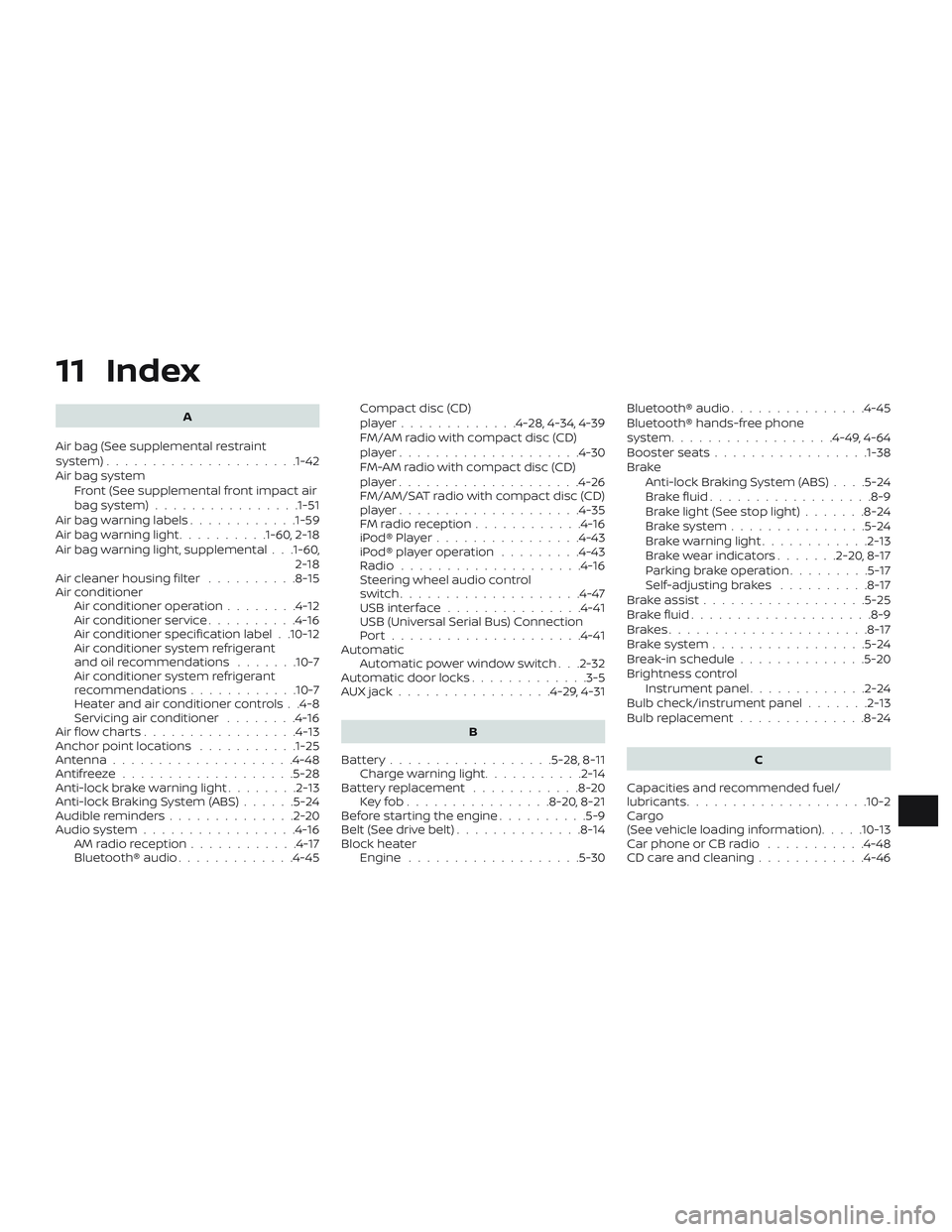
11 Index
A
Air bag (See supplemental restraint
system).....................1-42
Air bag system
Front (See supplemental front impact air
bagsystem)................1-51
Air bag warning labels............1-59
Airbagwarninglight..........1-60, 2-18
Air bag warning light, supplemental . . .1-60,
2-18
Air cleaner housing filter..........8-15
Air conditioner
Air conditioner operation........4-12
Air conditioner service..........4-16
Air conditioner specification label . .10-12
Air conditioner system refrigerant
and oil recommendations.......10-7
Air conditioner system refrigerant
recommendations............10-7
Heater and air conditioner controls . .4-8
Servicing air conditioner........4-16
Air flow charts.................4-13
Anchor point locations...........1-25
Antenna....................4-48
Antifreeze...................5-28
Anti-lock brake warning light........2-13
Anti-lock Braking System (ABS)......5-24
Audible reminders..............2-20
Audio system.................4-16
AMradioreception............4-17
Bluetooth® audio.............4-45Compact disc (CD)
player.............4-28,4-34,4-39
FM/AM radio with compact disc (CD)
player....................4-30
FM-AM radio with compact disc (CD)
player....................4-26
FM/AM/SAT radio with compact disc (CD)
player....................4-35
FMradioreception............4-16
iPod®Player................4-43
iPod® player operation.........4-43
Radio....................4-16
Steering wheel audio control
switch....................4-47
USBinterface...............4-41
USB (Universal Serial Bus) Connection
Port.....................4-41
Automatic
Automatic power window switch . . .2-32
Automatic door locks.............3-5
AUXjack.................4-29,4-31
B
Battery..................5-28,8-11
Charge warning light...........2-14
Battery replacement............8-20
Keyfob................8-20,8-21
Before starting the engine..........5-9
Belt(Seedrivebelt)..............8-14
Block heater
Engine...................5-30Bluetooth® audio...............4-45
Bluetooth® hands-free phone
system..................4-49,4-64
Booster seats.................1-38
Brake
Anti-lock Braking System (ABS)....5-24
Brakefluid..................8-9
Brakelight(Seestoplight).......8-24
Brakesystem...............5-24
Brakewarninglight............2-13
Brakewearindicators.......2-20,8-17
Parking brake operation.........5-17
Self-adjustingbrakes ..........8-17
Brakeassist..................5-25
Brakefluid....................8-9
Brakes......................8-17
Brakesystem.................5-24
Break-in schedule..............5-20
Brightness control
Instrument panel.............2-24
Bulb check/instrument panel.......2-13
Bulb replacement..............8-24
C
Capacities and recommended fuel/
lubricants....................10-2
Cargo
(See vehicle loading information).....10-13
Car phone or CB radio
...........4-48
CDcareandcleaning............4-46
Page 346 of 702

Precautions when starting and
driving.....................5-2
Push starting..................6-10
R
Radio
Car phone or CB radio..........4-48
FM-AM radio with compact disc (CD)
player ....................4-26
FM/AM radio with compact disc (CD)
player ....................4-30
FM/AM/SAT radio with compact disc (CD)
player ....................4-35
Steering wheel audio control
switch....................4-47
Readiness for inspection maintenance
(I/M)test....................10-20
Rearpowerwindows.............2-31
Rearseat.....................1-4
Rearviewmirror ................3-17
RearViewMonitor.............4-2,4-4
Rearwindowdefrosterswitch.......2-22
Recommended Fluids............10-2
Recorders
EventData.................10-20
Refrigerant recommendation........10-7
Registering a vehicle in another
country.....................10-10
Remote keyless entry system......3-6,3-7
Reporting safety defects (US only). . . .10-19S
Safety
Child safety rear door lock........3-6
Childseatbelts......1-20, 1-27, 1-33, 1-38
Reporting safety defects (US only) . .10-19
Seat adjustment
Front manual seat adjustment......1-3
Rear seat adjustment...........1-4
Seatback pockets...............2-28
Seat belt
Childsafety.................1-18
Infants and small children........1-18
InjuredPerson................1-13
Largerchildren...............1-19
Precautions on seat belt usage.....1-10
Pregnant women..............1-13
Seat belt extenders............1-17
Seat belt maintenance..........1-17
Seatbelts................1-10, 7-7
Shoulder belt height adjustment. . . .1-16
Three-pointtypewithretractor.....1-13
Seat belt extenders..............1-17
Seatbeltwarninglight .........1-13, 2-17
Seats
Adjustment..................1-2
Frontseats..................1-2
Manual front seat adjustment......1-3
Rearseat...................1-4
Self-adjustingbrakes.............8-17
Service manual order form.........10-21
Servicing air conditioner...........4-16
Shif ting
Continuously Variable Transmission
(CVT).....................5-12Manual transmission...........5-16
Shoulder belt height adjustment......1-16
Side air bag system (See supplemental
side air bag, curtain and rollover air bag
systems).....................1-57
Spark plug replacement...........8-14
Spark plugs...................8-14
Specifications.................10-8
Speedometer..................2-5
SRS warning label...............1-59
Stability control................5-26
Standard maintenance............9-8
Starting
Before starting the engine........5-9
Jumpstarting.............6-8,8-13
Precautions when starting and
driving.....................5-2
Push starting................6-10
Starting the engine............5-10
Starting the engine..............5-10
Steering
Power steering system..........5-23
Tilting steering wheel...........3-16
Steering wheel.................3-16
Steering wheel audio control switch . . .4-47
Stoplight....................8-24
Storage .....................2-27
Storagetray ..................2-28
Sunvisors....................3-16
Supplemental air bag warning labels . . .1-59
Supplemental air bag warning
light.....................1-60, 2-18
Supplemental front impact air bag
system......................1-51
Supplemental restraint system
Information and warning labels. . . .1-59
11-5
Page 454 of 702
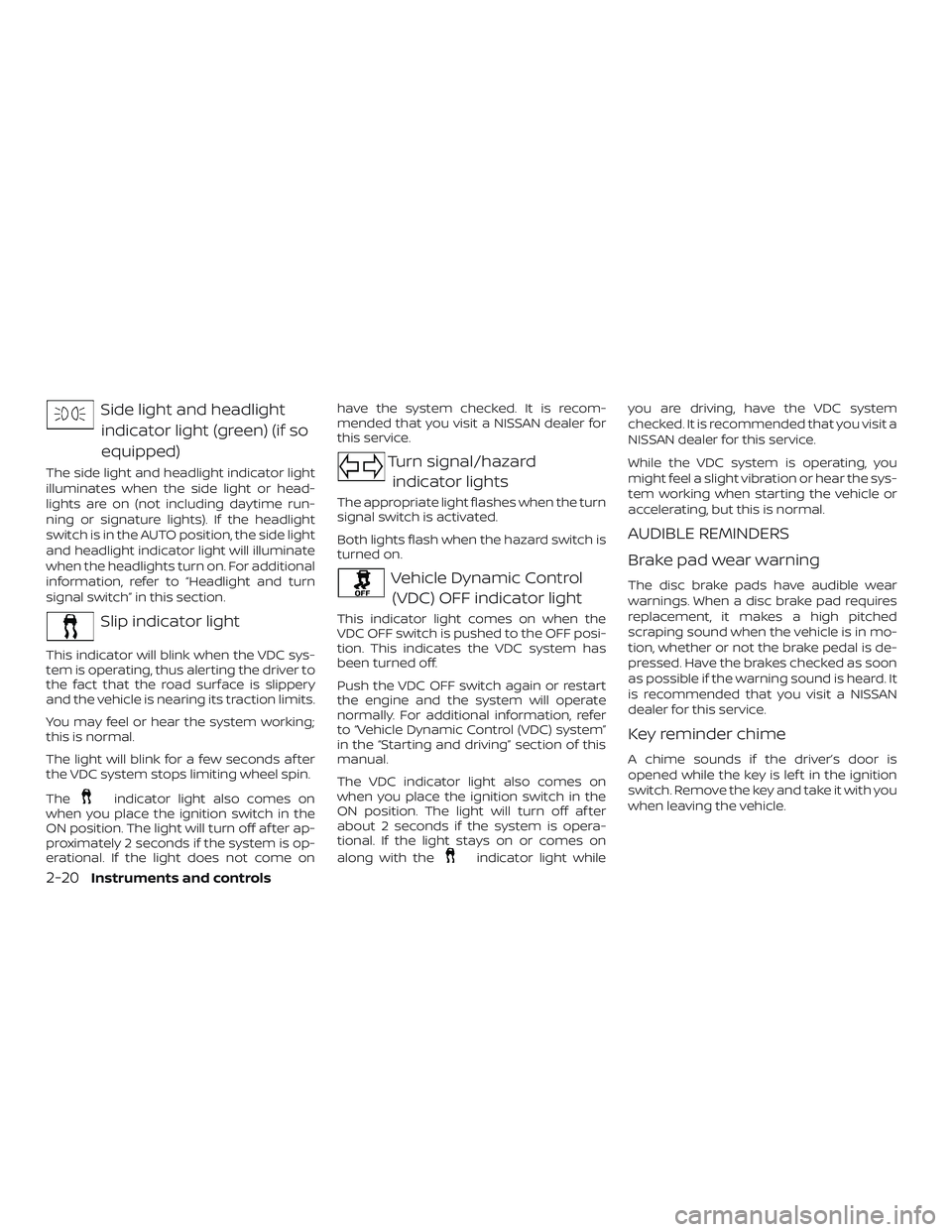
Side light and headlightindicator light (green) (if so
equipped)
The side light and headlight indicator light
illuminates when the side light or head-
lights are on (not including daytime run-
ning or signature lights). If the headlight
switch is in the AUTO position, the side light
and headlight indicator light will illuminate
when the headlights turn on. For additional
information, refer to “Headlight and turn
signal switch” in this section.
Slip indicator light
This indicator will blink when the VDC sys-
tem is operating, thus alerting the driver to
the fact that the road surface is slippery
and the vehicle is nearing its traction limits.
You may feel or hear the system working;
this is normal.
The light will blink for a few seconds af ter
the VDC system stops limiting wheel spin.
The
indicator light also comes on
when you place the ignition switch in the
ON position. The light will turn off af ter ap-
proximately 2 seconds if the system is op-
erational. If the light does not come on have the system checked. It is recom-
mended that you visit a NISSAN dealer for
this service.
Turn signal/hazard
indicator lights
The appropriate light flashes when the turn
signal switch is activated.
Both lights flash when the hazard switch is
turned on.
Vehicle Dynamic Control(VDC) OFF indicator light
This indicator light comes on when the
VDC OFF switch is pushed to the OFF posi-
tion. This indicates the VDC system has
been turned off.
Push the VDC OFF switch again or restart
the engine and the system will operate
normally. For additional information, refer
to “Vehicle Dynamic Control (VDC) system”
in the “Starting and driving” section of this
manual.
The VDC indicator light also comes on
when you place the ignition switch in the
ON position. The light will turn off af ter
about 2 seconds if the system is opera-
tional. If the light stays on or comes on
along with the
indicator light while you are driving, have the VDC system
checked. It is recommended that you visit a
NISSAN dealer for this service.
While the VDC system is operating, you
might feel a slight vibration or hear the sys-
tem working when starting the vehicle or
accelerating, but this is normal.
AUDIBLE REMINDERS
Brake pad wear warning
The disc brake pads have audible wear
warnings. When a disc brake pad requires
replacement, it makes a high pitched
scraping sound when the vehicle is in mo-
tion, whether or not the brake pedal is de-
pressed. Have the brakes checked as soon
as possible if the warning sound is heard. It
is recommended that you visit a NISSAN
dealer for this service.
Key reminder chime
A chime sounds if the driver’s door is
opened while the key is lef t in the ignition
switch. Remove the key and take it with you
when leaving the vehicle.
2-20Instruments and controls
Page 560 of 702
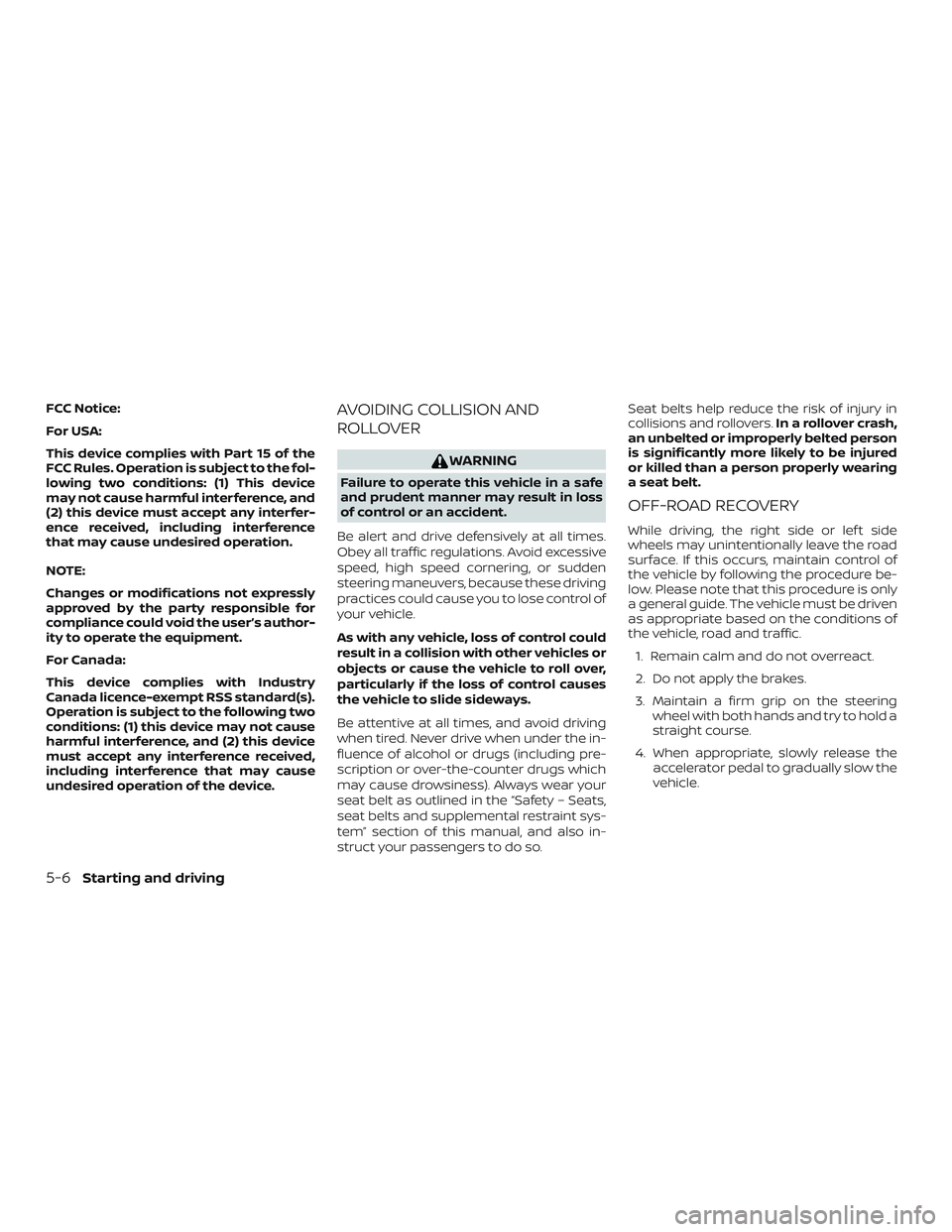
FCC Notice:
For USA:
This device complies with Part 15 of the
FCC Rules. Operation is subject to the fol-
lowing two conditions: (1) This device
may not cause harmful interference, and
(2) this device must accept any interfer-
ence received, including interference
that may cause undesired operation.
NOTE:
Changes or modifications not expressly
approved by the party responsible for
compliance could void the user’s author-
ity to operate the equipment.
For Canada:
This device complies with Industry
Canada licence-exempt RSS standard(s).
Operation is subject to the following two
conditions: (1) this device may not cause
harmful interference, and (2) this device
must accept any interference received,
including interference that may cause
undesired operation of the device.AVOIDING COLLISION AND
ROLLOVER
WARNING
Failure to operate this vehicle in a safe
and prudent manner may result in loss
of control or an accident.
Be alert and drive defensively at all times.
Obey all traffic regulations. Avoid excessive
speed, high speed cornering, or sudden
steering maneuvers, because these driving
practices could cause you to lose control of
your vehicle.
As with any vehicle, loss of control could
result in a collision with other vehicles or
objects or cause the vehicle to roll over,
particularly if the loss of control causes
the vehicle to slide sideways.
Be attentive at all times, and avoid driving
when tired. Never drive when under the in-
fluence of alcohol or drugs (including pre-
scription or over-the-counter drugs which
may cause drowsiness). Always wear your
seat belt as outlined in the “Safety – Seats,
seat belts and supplemental restraint sys-
tem” section of this manual, and also in-
struct your passengers to do so. Seat belts help reduce the risk of injury in
collisions and rollovers.
In a rollover crash,
an unbelted or improperly belted person
is significantly more likely to be injured
or killed than a person properly wearing
a seat belt.
OFF-ROAD RECOVERY
While driving, the right side or lef t side
wheels may unintentionally leave the road
surface. If this occurs, maintain control of
the vehicle by following the procedure be-
low. Please note that this procedure is only
a general guide. The vehicle must be driven
as appropriate based on the conditions of
the vehicle, road and traffic.
1. Remain calm and do not overreact.
2. Do not apply the brakes.
3. Maintain a firm grip on the steering wheel with both hands and try to hold a
straight course.
4. When appropriate, slowly release the accelerator pedal to gradually slow the
vehicle.
5-6Starting and driving
Page 561 of 702
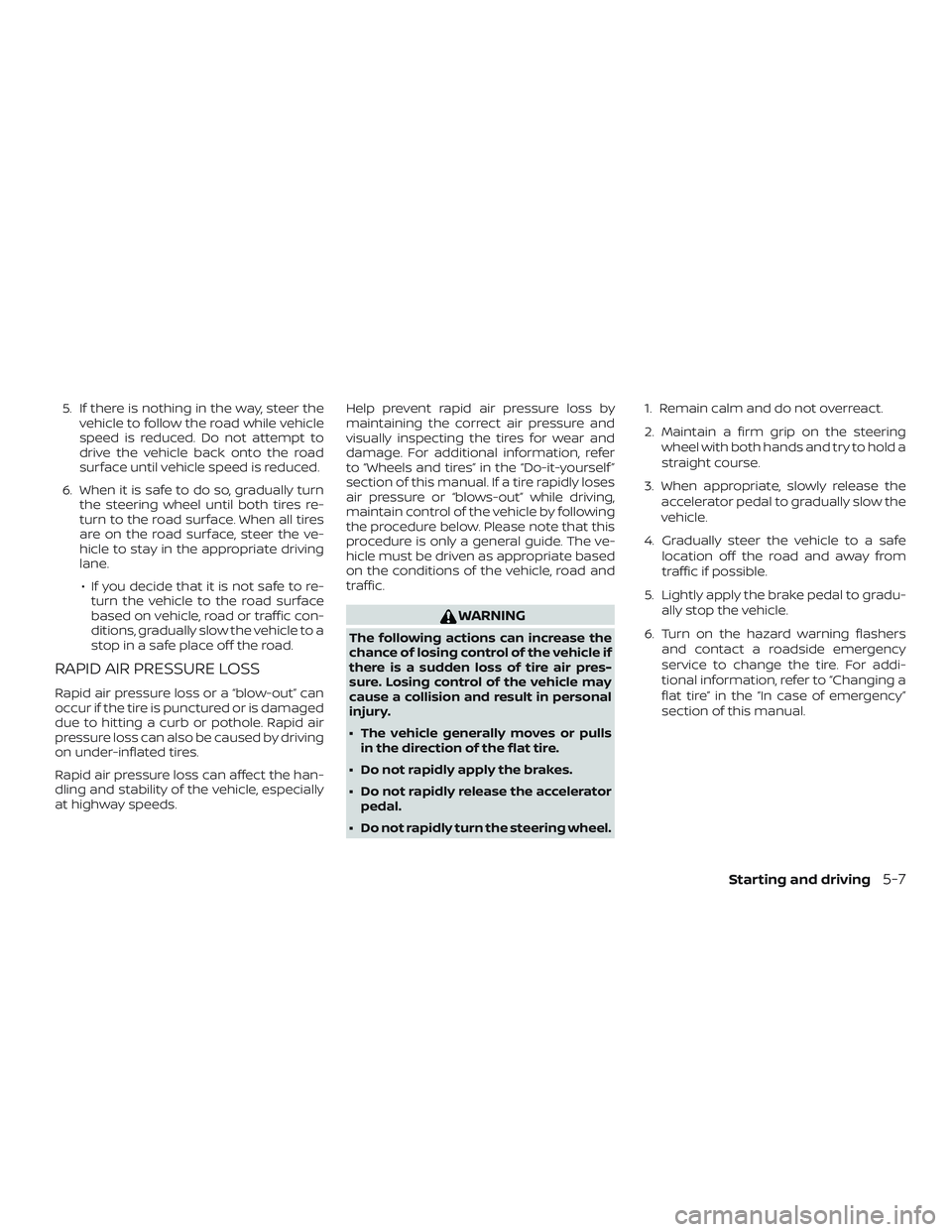
5. If there is nothing in the way, steer thevehicle to follow the road while vehicle
speed is reduced. Do not attempt to
drive the vehicle back onto the road
surface until vehicle speed is reduced.
6. When it is safe to do so, gradually turn the steering wheel until both tires re-
turn to the road surface. When all tires
are on the road surface, steer the ve-
hicle to stay in the appropriate driving
lane.
∙ If you decide that it is not safe to re- turn the vehicle to the road surface
based on vehicle, road or traffic con-
ditions, gradually slow the vehicle to a
stop in a safe place off the road.
RAPID AIR PRESSURE LOSS
Rapid air pressure loss or a “blow-out” can
occur if the tire is punctured or is damaged
due to hitting a curb or pothole. Rapid air
pressure loss can also be caused by driving
on under-inflated tires.
Rapid air pressure loss can affect the han-
dling and stability of the vehicle, especially
at highway speeds. Help prevent rapid air pressure loss by
maintaining the correct air pressure and
visually inspecting the tires for wear and
damage. For additional information, refer
to “Wheels and tires” in the “Do-it-yourself ”
section of this manual. If a tire rapidly loses
air pressure or “blows-out” while driving,
maintain control of the vehicle by following
the procedure below. Please note that this
procedure is only a general guide. The ve-
hicle must be driven as appropriate based
on the conditions of the vehicle, road and
traffic.
WARNING
The following actions can increase the
chance of losing control of the vehicle if
there is a sudden loss of tire air pres-
sure. Losing control of the vehicle may
cause a collision and result in personal
injury.
∙ The vehicle generally moves or pulls
in the direction of the flat tire.
∙ Do not rapidly apply the brakes.
∙ Do not rapidly release the accelerator pedal.
∙ Do not rapidly turn the steering wheel. 1. Remain calm and do not overreact.
2. Maintain a firm grip on the steering
wheel with both hands and try to hold a
straight course.
3. When appropriate, slowly release the accelerator pedal to gradually slow the
vehicle.
4. Gradually steer the vehicle to a safe location off the road and away from
traffic if possible.
5. Lightly apply the brake pedal to gradu- ally stop the vehicle.
6. Turn on the hazard warning flashers and contact a roadside emergency
service to change the tire. For addi-
tional information, refer to “Changing a
flat tire” in the “In case of emergency”
section of this manual.
Starting and driving5-7
Page 579 of 702
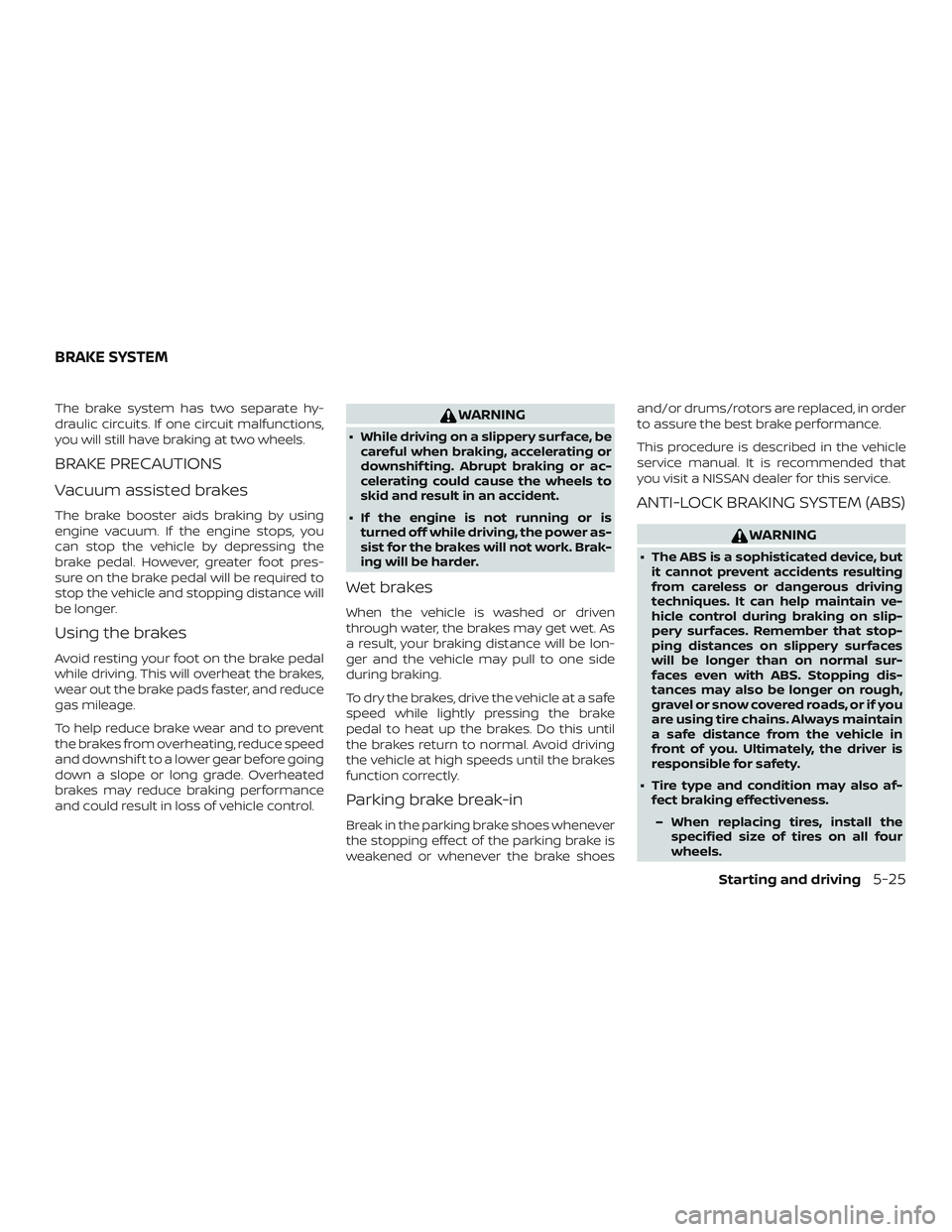
The brake system has two separate hy-
draulic circuits. If one circuit malfunctions,
you will still have braking at two wheels.
BRAKE PRECAUTIONS
Vacuum assisted brakes
The brake booster aids braking by using
engine vacuum. If the engine stops, you
can stop the vehicle by depressing the
brake pedal. However, greater foot pres-
sure on the brake pedal will be required to
stop the vehicle and stopping distance will
be longer.
Using the brakes
Avoid resting your foot on the brake pedal
while driving. This will overheat the brakes,
wear out the brake pads faster, and reduce
gas mileage.
To help reduce brake wear and to prevent
the brakes from overheating, reduce speed
and downshif t to a lower gear before going
down a slope or long grade. Overheated
brakes may reduce braking performance
and could result in loss of vehicle control.
WARNING
∙ While driving on a slippery surface, becareful when braking, accelerating or
downshif ting. Abrupt braking or ac-
celerating could cause the wheels to
skid and result in an accident.
∙ If the engine is not running or is turned off while driving, the power as-
sist for the brakes will not work. Brak-
ing will be harder.
Wet brakes
When the vehicle is washed or driven
through water, the brakes may get wet. As
a result, your braking distance will be lon-
ger and the vehicle may pull to one side
during braking.
To dry the brakes, drive the vehicle at a safe
speed while lightly pressing the brake
pedal to heat up the brakes. Do this until
the brakes return to normal. Avoid driving
the vehicle at high speeds until the brakes
function correctly.
Parking brake break-in
Break in the parking brake shoes whenever
the stopping effect of the parking brake is
weakened or whenever the brake shoes and/or drums/rotors are replaced, in order
to assure the best brake performance.
This procedure is described in the vehicle
service manual. It is recommended that
you visit a NISSAN dealer for this service.
ANTI-LOCK BRAKING SYSTEM (ABS)
WARNING
∙ The ABS is a sophisticated device, but
it cannot prevent accidents resulting
from careless or dangerous driving
techniques. It can help maintain ve-
hicle control during braking on slip-
pery surfaces. Remember that stop-
ping distances on slippery surfaces
will be longer than on normal sur-
faces even with ABS. Stopping dis-
tances may also be longer on rough,
gravel or snow covered roads, or if you
are using tire chains. Always maintain
a safe distance from the vehicle in
front of you. Ultimately, the driver is
responsible for safety.
∙ Tire type and condition may also af- fect braking effectiveness.
– When replacing tires, install the specified size of tires on all four
wheels.
BRAKE SYSTEM
Starting and driving5-25
Page 580 of 702
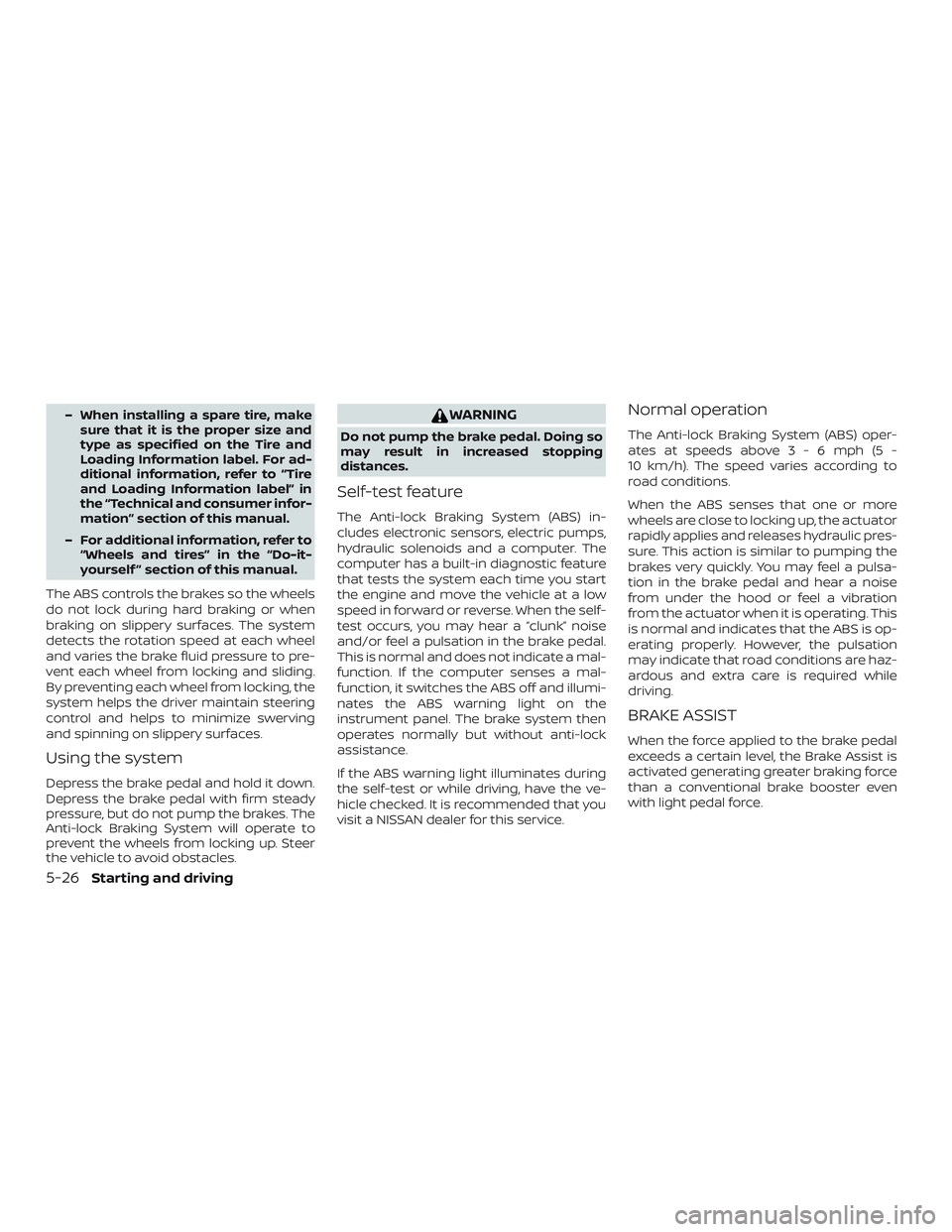
– When installing a spare tire, makesure that it is the proper size and
type as specified on the Tire and
Loading Information label. For ad-
ditional information, refer to “Tire
and Loading Information label” in
the “Technical and consumer infor-
mation” section of this manual.
– For additional information, refer to “Wheels and tires” in the “Do-it-
yourself ” section of this manual.
The ABS controls the brakes so the wheels
do not lock during hard braking or when
braking on slippery surfaces. The system
detects the rotation speed at each wheel
and varies the brake fluid pressure to pre-
vent each wheel from locking and sliding.
By preventing each wheel from locking, the
system helps the driver maintain steering
control and helps to minimize swerving
and spinning on slippery surfaces.
Using the system
Depress the brake pedal and hold it down.
Depress the brake pedal with firm steady
pressure, but do not pump the brakes. The
Anti-lock Braking System will operate to
prevent the wheels from locking up. Steer
the vehicle to avoid obstacles.
WARNING
Do not pump the brake pedal. Doing so
may result in increased stopping
distances.
Self-test feature
The Anti-lock Braking System (ABS) in-
cludes electronic sensors, electric pumps,
hydraulic solenoids and a computer. The
computer has a built-in diagnostic feature
that tests the system each time you start
the engine and move the vehicle at a low
speed in forward or reverse. When the self-
test occurs, you may hear a “clunk” noise
and/or feel a pulsation in the brake pedal.
This is normal and does not indicate a mal-
function. If the computer senses a mal-
function, it switches the ABS off and illumi-
nates the ABS warning light on the
instrument panel. The brake system then
operates normally but without anti-lock
assistance.
If the ABS warning light illuminates during
the self-test or while driving, have the ve-
hicle checked. It is recommended that you
visit a NISSAN dealer for this service.
Normal operation
The Anti-lock Braking System (ABS) oper-
ates at speeds abov e3-6mph(5-
10 km/h). The speed varies according to
road conditions.
When the ABS senses that one or more
wheels are close to locking up, the actuator
rapidly applies and releases hydraulic pres-
sure. This action is similar to pumping the
brakes very quickly. You may feel a pulsa-
tion in the brake pedal and hear a noise
from under the hood or feel a vibration
from the actuator when it is operating. This
is normal and indicates that the ABS is op-
erating properly. However, the pulsation
may indicate that road conditions are haz-
ardous and extra care is required while
driving.
BRAKE ASSIST
When the force applied to the brake pedal
exceeds a certain level, the Brake Assist is
activated generating greater braking force
than a conventional brake booster even
with light pedal force.
5-26Starting and driving
Page 611 of 702

8 Do-it-yourself
Maintenance precautions.......................8-2
Engine compartment check locations ...........8-3
Engine cooling system ..........................8-4
Checking engine coolant level ................8-5
Changing engine coolant .....................8-5
Engine oil ........................................8-6
Checking engine oil level .....................8-6
Changing engine oil ..........................8-7
Changing engine oil filter .....................8-8
Continuously Variable Transmission (CVT)
fluid (if so equipped) .............................8-9
Brake and clutch (if so equipped) fluid ...........8-9
Brake fluid ................................... 8-10
Clutch (if so equipped) fluid ..................8-10
Windshield-washer fluid ........................8-10
Windshield-washer fluid reservoir ............8-10
Battery.......................................... 8-11
Jump starting ............................... 8-13
Variable voltage control system
(if so equipped) ................................. 8-13
Drive belt ....................................... 8-14
Spark plugs .................................... 8-15Replacing spark plugs
....................... 8-15
Air cleaner ...................................... 8-15
Windshield wiper blades ........................8-16
Cleaning .................................... 8-16
Replacing ................................... 8-16
Brakes.......................................... 8-17
Fuses ........................................... 8-18
Engine compartment .......................8-18
Passenger compartment ....................8-19
Battery replacement ........................... 8-21
Key fob (if so equipped) ......................8-21
Lights .......................................... 8-22
Headlights ................................... 8-22
Fog lights (if so equipped) ...................8-24
Exterior and interior lights ...................8-24
Wheels and tires ................................ 8-28
Tire pressure ................................ 8-28
Tire labeling ................................. 8-31
T
ypes of tires ................................ 8-34
Tire chains .................................. 8-35
Changing wheels and tires ..................8-36